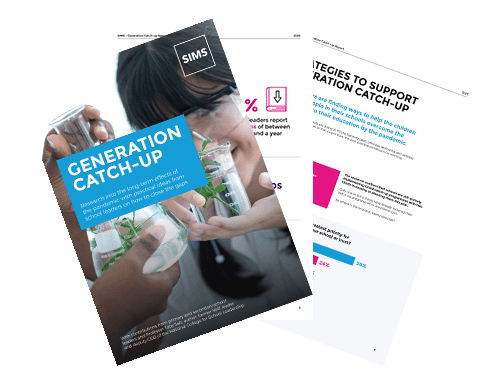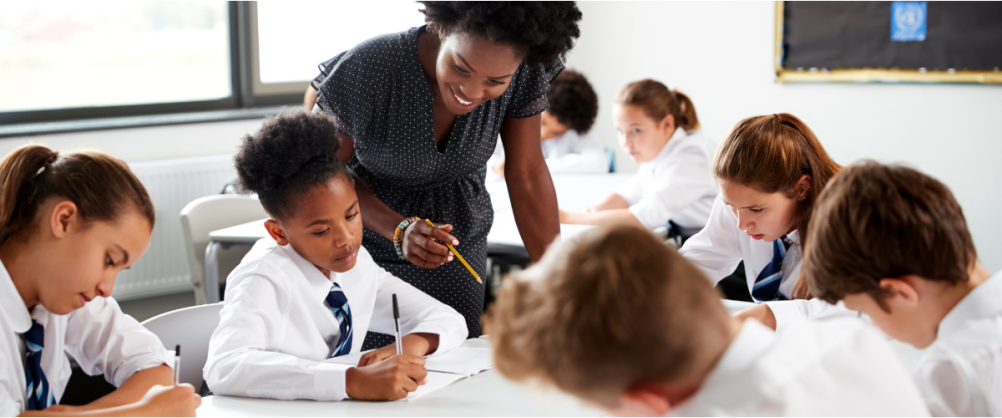“The legacy of Covid continues to affect children across the UK and many are experiencing challenges relating to their learning and wellbeing since the pandemic.”
Those are the words of Professor Toby Salt, former MAT leader and deputy CEO of the National College for School Leadership.
School leaders from primary and secondary schools across the country feel the same way. It would appear that children’s learning, progress and outcomes are suffering from their own form of Long Covid.
The Generation Catch-Up Report, our comprehensive survey of 500 school leaders, revealed that the overwhelming majority (96%) agree that post-pandemic learning gaps remain an issue, especially in key year groups.
Worryingly, almost two-thirds (61%) of respondents describe the impact on learning as ‘major’, with 41% citing pupil mental health and wellbeing as a barrier to learning.
So, what are school leaders saying about the lasting impact of COVID-19 on their students and schools?
1. Younger primary school children missed out on the foundations of learning
A third (32%) of school leaders say the current Year 4 cohort is the worst affected by learning loss. It’s perhaps notable that these children were in Reception at the start of the pandemic, a time when schools were closed to most pupils.
As we know, the early years are crucial to a child’s personal, social, cognitive, and academic development, and school is the best place to build these skills both as part of the curriculum and by spending time with peers. Current Year 4 pupils also had their transition from EYFS to KS1 interrupted by multiple lockdowns, a period that is crucial in a child’s development.
These factors may explain why this cohort has been adversely affected by being out of school, as Donna Faley, Headteacher at St Thomas More Catholic Primary School, explains.
“Children right from Year 4 down to Year 1 are much more affected by learning gaps than the older children, who already had those early reading skills in place before the pandemic. They have missed out on developing key skills due to lockdowns and Covid bubble closures, meaning they don’t have solid foundations in place for learning.”
2. Gaps in learning for students in all secondary school year groups
While the effects of Covid-19 are evident in every secondary year group, from low levels of literacy to lack of preparation for external exams, Year 10 children are considered the most severely affected by pandemic-related learning loss.
In a similar way to the current Year 4 cohort, these children, who were in Year 6 at the start of the pandemic, had an important transition period disrupted by a series of lockdowns. Moving up to secondary school is a crucial time for pupils from a social, mental and academic perspective, so it’s little wonder that the effects are still being felt today.
Learning gaps amongst Year 10 students are particularly concerning for school leaders, as these pupils are preparing to sit GCSEs while still trying to catch up on missed learning opportunities and content.
3. Children from all backgrounds have been affected by the pandemic
37% of school leaders say children from disadvantaged backgrounds give them the most cause for concern, and 18% are most worried about children with SEND. However, a larger proportion – 40% feel pandemic learning gaps are having an impact across the board.
To add to the complex picture, there has been a change in the pattern of needs, as Chris Kitchen, assistant head of Ysgol Aberconwy Secondary, explains. “Our intake is diverse; we have very affluent families as well as pupils from really deprived areas, and we have always focused on closing the gap.
“But many pupils in the middle who we were not previously concerned about have dropped behind. The pandemic has changed society.”
4. Learning loss of between six months and a year
Without statutory testing in every year group, the degree of learning loss is tricky to quantify accurately. However, almost three-quarters (70%) of school leaders agree that between half an academic year and a whole academic year had been ‘lost’ due to the pandemic; 10% go further and say that the extent of learning loss is one to two academic years.
Clearly, it’s going to take time, expertise, and carefully crafted interventions to close such enormous gaps. It may take even longer than a couple more years to see a difference, according to Ieuan Price, Director of Digital Learning at St Illtyd’s Catholic High School:
“Children might need to go right through the education system to fill their learning gaps.
“The children in Reception over lockdown missed out on all the early foundation work those teachers put in place, and if children further up in primary and secondary school lack literacy skills, they will be held back in their other subjects too.”
On a positive note, our survey highlights some innovative and creative strategies teachers are using to reduce learning gaps, and improve wellbeing, behaviour and attendance – steps that will, over time, lead to improved outcomes for all.

Bridging the learning gaps
The report confirms that schools are still actively implementing Covid catch-up programmes to bridge learning gaps, and 51% had increased their catch-up provision and are using it on targeted interventions. The top priority is literacy and English, according to more than half of all school leaders (56%), while nearly a quarter (24%) consider maths to be the priority.
Schools are making changes to the timetable and adjusting the school day in order to deliver targeted and individual tuition, and where there are learning gaps across a year group, teachers are breaking learning down into smaller chunks and allowing more explanation time in lessons.
Improving student wellbeing
The report confirms school leaders’ concern about mental health and wellbeing and interestingly, 15% of school leaders are focusing Covid catch-up provision on social and emotional development.
Schools are encouraging students to open up about their anxieties and support each other through activities, clubs and shared spaces. There is also a renewed focus on preparing for anxiety hotspots such as exam season, the beginning of term and school social events.
More children have become vulnerable since the pandemic and schools are finding ways to identify these students and put support in place for them.
Managing behaviour
18% of school leaders say poor behaviour has had the greatest negative impact on pupils’ learning, and many behaviour incidents are linked to socialisation issues caused by the pandemic.
Since the pandemic, it has become even more important to have accurate information about trends in behaviour to inform decisions about the best paths of action to take, such as addressing issues in whole school assemblies, tutor time or as part of the curriculum.
Schools are also keeping in regular contact with parents with digestible and friendly communications but with a view to shifting the responsibility over to the student for their behaviour and achievement.
Raising attendance
13% of school leaders say low attendance since the pandemic has had the greatest impact on pupils’ learning.
Children are taking more days out of school than before Covid and school leaders are having to balance a tough stance on attendance with a softer approach to make students feel welcome and comfortable on their return to school.
There is a need to encourage students and parents to see the value of school and to help them understand the impact that prolonged absence can have on a child’s learning and wellbeing.
There is no doubt that the disruption caused by the pandemic has had a far-reaching effect on the education and wellbeing of a generation. However, as the school leaders in our report have demonstrated, so much can be achieved by working together to get children and young people back on track with their learning, confidence and resilience.
Their support will ensure Generation Catch Up can look forward to a bright future.
To access our extensive, in-depth report, or to find out more about school leaders’ gap-closing strategies, download a complimentary copy of the Generation Catch-Up Report.
And look out for our upcoming blogs with more insight from the Generation Catch Up report on:
- How schools are tackling pandemic-related learning gaps
- How schools are supporting student wellbeing since the pandemic

